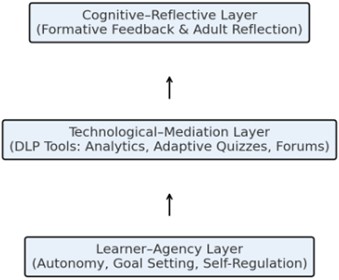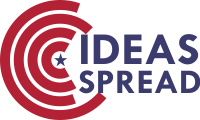Integrating Formative Assessment with Adult Learning Theory for Enhanced Digital Learning Platforms
Abstract
Rapid advances in information technology have transformed education, enabling the proliferation of digital learning platforms (DLPs) that support flexible and diverse learning modalities. Concurrently, the growing demand for adult lifelong learning highlights the need to tailor digital platforms to the unique characteristics of adult learners, including autonomy, experiential grounding, and intrinsic motivation. Formative Assessment (FA), emphasizing continuous feedback and reflective engagement, offers a promising approach to enhancing learning effectiveness. However, existing DLPs often lack systematic integration of FA principles with adult learning theory (ALT), limiting their pedagogical impact. This study proposes the FA–ALT–DLP Integration Model, synthesizing formative assessment practices, adult learning principles, and digital platform affordances. The model operationalizes four key dimensions: supporting learner autonomy, personalizing feedback, leveraging experiential knowledge, and facilitating critical reflection. By aligning pedagogical intent with technological capabilities and adult learner characteristics, the model provides both theoretical insights and practical guidance for optimizing digital platforms. The study contributes to educational research by bridging assessment, adult education, and technology-enhanced learning, and offers actionable strategies for platform designers and educators to foster autonomous, reflective, and transformative learning experiences among adult learners.
References
[2] Brookfield, S. D. (2013). Self-directed learning. In R. M. English (Ed.), Adult learning and education (pp. 54-65). Routledge.
[3] Brookhart, S. M. (2017). How to give effective feedback to your students (2nd ed.). ASCD.
[4] Candy, P. C. (1991). Self-direction for lifelong learning: A comprehensive guide to theory and practice. Jossey-Bass.
[5] Fischer, G., Herrmann, T., & Konomi, S. (2020). Personalized and competency-based learning in digital environments. Springer.
[6] Gašević, D., Dawson, S., & Siemens, G. (2015). Let's not forget: Learning analytics are about learning. TechTrends, 59(1), 64-71. https://doi.org/10.1007/s11528-014-0822-x
[7] Garrison, D. R., Anderson, T., & Archer, W. (2000). Critical inquiry in a text-based environment: Computer conferencing in higher education. The Internet and Higher Education, 2(2-3), 87-105. https://doi.org/10.1016/S1096-7516(00)00016-6
[8] Garrison, D. R., & Vaughan, N. D. (2008). Blended learning in higher education: Framework, principles, and guidelines. Jossey-Bass. https://doi.org/10.1002/9781118269558
[9] Ifenthaler, D., & Yau, J. Y. K. (2020). Utilising learning analytics to support study success in higher education: A systematic review. Educational Technology Research and Development, 68(4), 1961-1990. https://doi.org/10.1007/s11423-020-09788-z
[10] Kearney, M., Schuck, S., Burden, K., & Aubusson, P. (2012). Mobile learning in mathematics: An emerging pedagogical paradigm. Journal of Computers in Mathematics and Science Teaching, 31(2), 153-171.
[11] Knowles, M. S. (1973). The adult learner: A neglected species. Gulf Publishing.
[12] Knowles, M. S. (1980). The modern practice of adult education: From pedagogy to andragogy (2nd ed.). Cambridge Books.
[13] Knowles, M. S. (1984). Andragogy in action: Applying modern principles of adult education. Jossey-Bass.
[14] Mezirow, J. (1991). Transformative dimensions of adult learning. Jossey-Bass. https://doi.org/10.1177/104515959100300116
[15] Mezirow, J. (2000). Learning as transformation: Critical perspectives on a theory in progress. Jossey-Bass.
[16] Mezirow, J. (2009). Transformative learning theory. In J. Mezirow & E. W. Taylor (Eds.), Transformative learning in practice: Insights from community, workplace, and higher education (pp. 18-32). Jossey-Bass.
[17] Merriam, S. B., & Bierema, L. L. (2014). Adult learning: Linking theory and practice. Jossey-Bass.
[18] Nguyen, T., Shera, D., & Lee, M. (2021). Formative assessment and digital learning platforms: Bridging the gap. Computers & Education, 165, 104139.
[19] Nicol, D. J., & Macfarlane‐Dick, D. (2006). Formative assessment and self‐regulated learning: A model and seven principles of good feedback practice. Studies in Higher Education, 31(2), 199-218. https://doi.org/10.1080/03075070600572090
[20] Panadero, E., Andrade, H., & Brookhart, S. (2018). Fusing self-regulated learning and formative assessment: A roadmap of where we are, how we got here, and where we are going. The Australian Educational Researcher, 45(1), 13-31. https://doi.org/10.1007/s13384-018-0258-y
[21] Sadler, D. R. (1989). Formative assessment and the design of instructional systems. Instructional Science, 18(2), 119-144. https://doi.org/10.1007/BF00117714
[22] Scriven, M. (1967). The methodology of evaluation. In R. W. Tyler, R. M. Gagné, & M. Scriven (Eds.), Perspectives of curriculum evaluation (pp. 39-83). Rand McNally.
[23] Shute, V. J. (2008). Focus on formative feedback. Review of Educational Research, 78(1), 153-189. https://doi.org/10.3102/0034654307313795
[24] Shute, V. J., & Rahimi, S. (2021). Review of computer-based assessment for learning in elementary and secondary education. Journal of Computer Assisted Learning, 37(1), 1-19. https://doi.org/10.1111/jcal.12172
[25] Siemens, G., & Baker, R. S. J. d. (2012). Learning analytics and educational data mining: Towards communication and collaboration. In Proceedings of the 2nd International Conference on Learning Analytics and Knowledge (pp. 252-254). ACM. https://doi.org/10.1145/2330601.2330661
[26] Tough, A. (1971). The adult's learning projects: A fresh approach to theory and practice in adult learning. Ontario Institute for Studies in Education.
[27] Veletsianos, G., & Shepherdson, P. (2016). A systematic analysis and synthesis of the empirical MOOC literature published in 2013-2015. The International Review of Research in Open and Distributed Learning, 17(2), 198-221. https://doi.org/10.19173/irrodl.v17i2.2448
[28] Watson, W. R., & Watson, S. L. (2007). An argument for clarity: What are learning management systems, what are they not, and what should they become? TechTrends, 51(2), 28-34. https://doi.org/10.1007/s11528-007-0023-y
[29] Zimmerman, B. J. (2002). Becoming a self-regulated learner: An overview. Theory Into Practice, 41(2), 64-70. https://doi.org/10.1207/s15430421tip4102_2
[30] Zawacki-Richter, O., Marín, V. I., Bond, M., & Gouverneur, F. (2019). Systematic review of research on artificial intelligence applications in higher education - where are the educators? International Journal of Educational Technology in Higher Education, 16(1), 39. https://doi.org/10.1186/s41239-019-0171-0


This work is licensed under a Creative Commons Attribution 4.0 International License.
Copyright for this article is retained by the author(s), with first publication rights granted to the journal.
This is an open-access article distributed under the terms and conditions of the Creative Commons Attribution license (http://creativecommons.org/licenses/by/4.0/).








1.png)

















